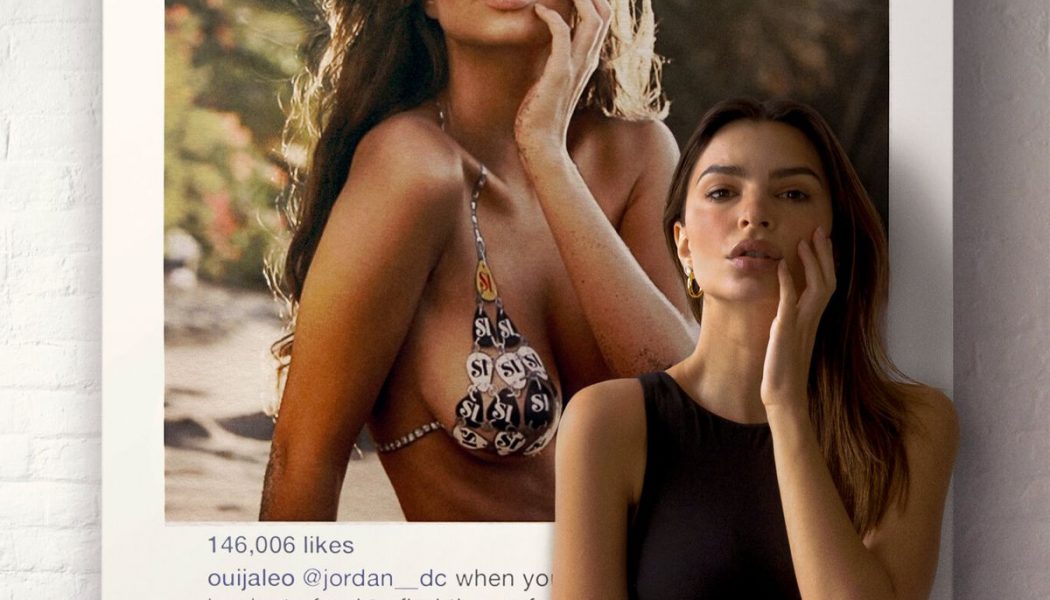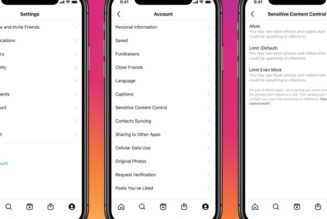Model and actress Emily Ratajkowski is selling a link representing a composite image that features a photograph of herself in front of a print by another artist that contains a photo (of herself) taken by (presumably) yet another artist. In other words, she is selling an NFT.
The New York Times reports that Ratajkowski will be selling the NFT at Christie’s, the storied auction house that sold Beeple’s NFT for $69 million in March. The NFT is, for Ratajkowski, an effort to reclaim images of herself that have been created and sold, sometimes without her permission, throughout her career. Last year, Ratajkowski published an essay in The Cut describing moments when she was unable to control often vulnerable images of herself.
:no_upscale()/cdn.vox-cdn.com/uploads/chorus_asset/file/22465946/23EMRATANFT_superJumbo.jpg)
“As somebody who has built a career off of sharing my image, so many times — even though that’s my livelihood — it’s taken from me and then somebody else profits off of,” Ratajkowski told The New York Times. The NFT, titled “Buying Myself Back: A Model for Redistribution,” is meant to let Ratajkowski profit directly, continually, and significantly off of works containing her image that she did not previously have much (or any) stake in.
The NFT, also, is a copyright nightmare, much like many of the images that Ratajkowski described grappling with throughout her career. To break down the situation at hand:
- There is the NFT. An NFT contains, essentially, just a link, but the terms of sale imply ownership over whatever the NFT links to. Ratajkowski can definitively sell a link. Is she really selling the underlying image? Are all NFTs a sham? Further study is needed.
- The composite artwork being NFT-ized contains two discrete images: the first is a photo of Ratajkowski in her apartment, the second is (what appears to be) a digital copy of a “painting” by Richard Prince. Someone owns the foreground photo of Ratajkowski in her apartment (possibly the photographer, possibly Ratajkowski herself). Ratajkowski owns a physical copy of the painting by Richard Prince, but she likely does not own rights to digitally reproduce it.
- The Richard Prince painting is itself a copyright nightmare. It is a print of an Instagram post by Ratajkowski, which features a photo of Ratajkowski taken for Sports Illustrated, as well as a profile photo of Ratajkowski (possibly a selfie?) and comments written by other viewers of the photo. Richard Prince almost certainly did not get permission to use either of the photos or the comments included in his painting. Is the font copyright protected, too? Please help me.
- This is an entire bullet point just to mention that Richard Prince’s entire thing as an artist is transforming other artists’ work, sometimes in fascinating ways, other times in really gimmicky ways, and seemingly always in ways that inevitably piss people off because he ends up making a ton of money off of minor alternations to someone else’s art. This approach has resulted in many complaints and lawsuits, which have mostly worked out in Prince’s favor, insofar as he has continued to work and make a lot of money.
- Ratajkowski is trolling Richard Prince by stealing his move, transforming his own work (a transformation of her), and reselling it (seemingly without his permission). Honestly, good work here.
- If we’re counting: there seem to be at least four images within this single image. We can reasonably assume that Ratajkowski owns two of them (the core photo of herself, plus her profile picture inside the Richard Prince painting). Richard Prince owns one of them (although that could be litigated). And Sports Illustrated and/or a photographer associated with Sports Illustrated presumably owns the final image.
- You’ve gotta assume Richard Prince isn’t suing over this.
- Ratajkowski has become, perhaps by necessity, a consistent proponent for allowing transformative use of photographs. In a lawsuit over a paparazzo’s photo she posted to her Instagram Story with a caption over top of it, Ratajkowski has argued that her amendment to the photograph should qualify her work for fair use protections. (This is, of course, the same general argument that Richard Prince makes about his work. It’s messy!) A similar, albeit more deliberate, situation is at play here.
- More broadly, Ratajkowski seems to be pushing for a rethinking of copyright law that would give subjects more control over how their images are displayed and who profits off of them.
- Maybe none of this matters anyway because, again, what even is an NFT?
Ratajkowski will receive a cut every time her NFT is resold, therefore giving herself some degree of continued ownership over her image(s).
The digital terrain should be a place where women can share their likeness as they choose, controlling the usage of their image and receiving whatever potential capital attached. Instead, the internet has more frequently served as a space where others exploit and distribute image
— Emily Ratajkowski (@emrata) April 23, 2021
And here’s the wonderful thing about doing this all on the blockchain and other distributed networks: say copyright law comes crashing down on Ratajkowski, say the profits are taken from her and she’s ordered to stop marketing the NFT and reposting the image in the future — there’s still nothing anyone can do to wipe out the image. It’ll still be linked on the blockchain and hosted on a distributed network where she wanted it.










